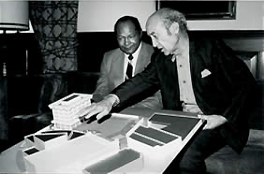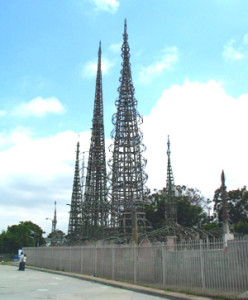Los Angeles: Birthplace of Multiculturalism
Coming Home to Azusa Street Mission A Hundred Years Later.
A hundred years ago, a seed was planted by a son of former slaves to create a multicultural Los Angeles. In 1906, the establishment of a multiracial mission on Azusa Street by Pastor William Joseph Seymour turned everything upside down in Los Angeles. “All the major churches were trying to figure out how to relate to it,” according to Cecil M Robeck, Jr., professor of church history at Fuller Theological seminary and an authority on the Pentecostal Movement. Today, the seed that Pastor Seymour planted has created a multiracial movement throughout America, Europe, Africa, Asia and Latin America. The Pentecostal Church is the fastest growing religious movement in the world with over 500 million members.
312 Azusa Street Mission and Pastor Seymour
and members of the Pentecostal Church
(Image courtesy of Los Angeles Public Library)
A Multicultural River of Renewal will be flowing through Los Angeles in April 2006 to commemorate Pastor William Seymour and the birthplace of the Pentecostal Movement. Seymour is one of the 100 most important people, and the Movement is one of the most important events in the history of the millennium, according to the “Life Millennium Collector’s Edition.” Yet the amazing story of Pastor Seymour is hardly known outside of Pentecostal circles. The breadth of his impact on the world has not been fully appreciated, up to now, but the power of this river of faith, the historical and cultural impact of this centennial celebration will empower the dream of a multicultural Los Angeles and a world community. The international impact of this Centennial pilgrimage to Los Angeles will combine with a number of other efforts to put Los Angeles in the enviable position as one of the prime cultural tourist destinations of the world.
Importance to America
The Pentecostal Movement is important to Los Angeles and America because it was founded in Los Angeles and it is an American Multicultural Religious Movement with world impact. In this regard, William Seymour stands shoulder to shoulder with Nelson Mandela, Martin Luther King and other great leaders of African descent in the 20th century.
The site of the Azusa Street Mission involves another notable person of African American ancestry – Ms. Biddy Mason. Biddy Mason, a former slave, who became a wealthy businesswoman in Los Angeles, founded the First AME (African Methodist Episcopal) Church at 312 Azusa Street in Little Tokyo. She sold the property to William Seymour that became the Azusa Street Mission.
Knowing neither its existence nor its historical significance, Isamu Noguchi, a world renowned sculptor, convinced Mayor Bradley, the first African American Mayor of Los Angeles, to build a plaza on the site of the Azusa Street Mission. A theatre had been planned for the site. In 1980, Tom Bradley was able to convince the Japanese American Cultural and Community Center Board of Directors to create a plaza on the Azusa Street Mission site and locate the planned theater at its present location.
Isamu Noguchi explaining to Mayor Tom Bradley about the development of the plaza (Image courtesy of Los Angeles Public Library)
Tom Bradley believed that the strength of Los Angeles was the diversity of all of its people. He provided the leadership to create a multicultural Los Angeles by generating an inclusive political foundation and framework for the City. He brought the 1984 Olympics to Los Angeles, one of the most ethnically diverse cities in the world where Olympians from over 85 countries were welcomed by Angelinos from those countries. Mayor Bradley provided the leadership to create a multicultural city by empowering ethnic minorities to become part of the City’s workforce through an aggressive Affirmative Action Program. Together with Gilbert Lindsey, the first African American councilman in the City of Los Angeles, they provided the leadership for the redevelopment of Little Tokyo.
Currently, Jan Perry, Councilwoman for the Little Tokyo District, provides the leadership to recapture the Spirit of Multiculturalism and has endorsed the Azusa Street SpiritWalk Promenade as an important historical cultural tourism venue for the City of Los Angeles.
Little Tokyo is “The Spiritual Door to the World” with the Buddhist and Christian churches providing the moral leadership and the soul to this multicultural community. With the arrival of the pilgrims in April, the Azusa Street Mission will become one of the greatest cultural tourist attractions in Los Angeles. Over a half billion followers, worldwide, have been inspired by the amazing events that took place a century ago that closely parallel the Biblical story of Pentecost. Positioning for this economic boom for the downtown district of the City of Los Angeles, the Azusa Street Memorial Committee and the Tom Bradley Legacy Foundation are working with the community to envision and implement the Azusa Street SpiritWalk Promenade to provide the soul to the growing downtown urban center.
Azusa Street
Little Tokyo will again become a living experiment in multiculturalism where all religions and ethnic groups can live and work towards inspiring the spirit of brotherhood still emanating from this historical site. After his experience at the Azusa Street Mission, Simon Rodia, went on to build the Watts Towers, another cultural treasure imbued with the “Spirit and Power of the Dream.” At a local Pentecostal Church in Memphis, Tennessee, Elvis Presley experienced and was inspired by the gospel music performed by the Black musicians that originated from the Movement. Elvis help spark a new music movement-Rock and Roll—that changed the music world and profoundly influenced a generation.
Simon Rodia’s Watts Towers inspired by the Azusa Street Mission Experience.
One hundred years after Rev. William Seymour, a legendary “big dreamer” inspired a multicultural world movement in the city of 250,000 people, Mayor Villaraigosa, the first elected Latino Mayor in the City of 3.5 million people, is inspiring Angelinos to “dream big” to create a renewed city of Angels.
We are of one race–the human race-living in a multicultural city. The strength of Los Angeles is rooted in the dreams of all those diverse cultural heritages from all countries. The City of Angels is the “Birthplace of Multiculturalism” and we are coming home to Azusa Street Mission a hundred years later to renew our commitment to make the Multicultural Dream in the city of Angels a reality.
“Los Angeles: Birthplace of Multiculturalism,” written by Les Hamasaki





